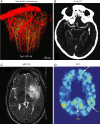Imaging the aged brain: pertinence and methods
- PMID: 31281780
- PMCID: PMC6571189
- DOI: 10.21037/qims.2019.05.06
Imaging the aged brain: pertinence and methods
Abstract
The global population is ageing at an accelerating speed. The ability to perform working memory tasks together with rapid processing becomes increasingly difficult with increases in age. With increasing national average life spans and a rise in the prevalence of age-related disease, it is pertinent to discuss the unique perspectives that can be gained from imaging the aged brain. Differences in structure, function, blood flow, and neurovascular coupling are present in both healthy aged brains and in diseased brains and have not yet been explored to their full depth in contemporary imaging studies. Imaging methods ranging from optical imaging to magnetic resonance imaging (MRI) to newer technologies such as photoacoustic tomography each offer unique advantages and challenges in imaging the aged brain. This paper will summarize first the importance and challenges of imaging the aged brain and then offer analysis of potential imaging modalities and their representative applications. The potential breakthroughs in brain imaging are also envisioned.
Keywords: Brain imaging; aging; magnetic resonance imaging (MRI); neuroscience; neurovascular coupling; optical imaging; positron emission tomography.
Conflict of interest statement
Conflicts of Interest: The authors have no conflicts of interest to declare.
Figures





References
-
- Wen YM. Health in an Aging World: What Should We Do? Engineering 2016;2:40-3. 10.1016/J.ENG.2016.01.010 - DOI
-
- Ferri CP, Schoenborn C, Kalra L, Acosta D, Guerra M, Huang YQ, Jacob KS, Rodriguez JJL, Salas A, Sosa AL, Williams JD, Liu ZR, Moriyama T, Valhuerdi A, Prince MJ. Prevalence of stroke and related burden among older people living in Latin America, India and China. J Neurol Neurosurg Psychiatry 2011;82:1074-82. 10.1136/jnnp.2010.234153 - DOI - PMC - PubMed
Publication types
Grants and funding
LinkOut - more resources
Full Text Sources
